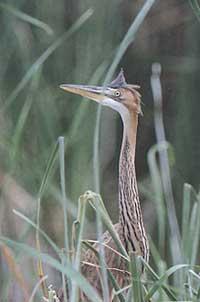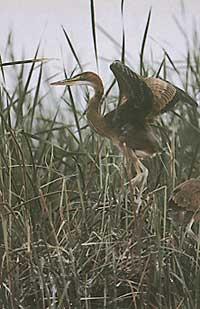Red heron, southern bird

When talking about birds in wet environments, it is essential to mention the family of ardeidos formed by egrets, egrets, etc. that, probably, together with analogous and limicolos, present the most remarkable adaptations to the aquatic ecosystems of our region.
The red heron (Ardea purpurpurea) is a typical heron, so the most visible characteristics of this species are the same that define the family. The red heron is also an elegant bird of great slenderness, characterized by its long and thin parts of the body: a sharp beak in the form of azconas, and the long flexible neck, with appropriate hunting tools, thanks to its long and thin legs between the vegetation of the banks of the rivers, or through the lakes and reeds of the marshes.

On the other hand, in the case of the red heron, and as the name suggests, brown predominates. On the neck, on the reeds where it inhabits, there is a decoration of long longitudinal cryptic lines that extend along the chest and to the ventral area. The dorsal part, on the other hand, is gray, although from here also hang on the ribs a long and brown dusters. Although it usually resembles the royal heron (Ardea cinerea), the red heron is usually somewhat smaller, with a total length of 75-80 cm and a width of wings of about 150 cm, with a weight ranging between 800 and 1,250 g.
As for the place of residence, the red heron is usually more watery than the rest of the trees, although they are all inhabitants of humid areas. The red heron sits in marshes, lagoons and river margins, although in all of them aquatic vegetation is considered as an indispensable condition. However, the demanding demand imposed from the plant point of view is mainly associated with the reed. The red heron does not have a close relationship with other trees.
Like the rest of the herons, the red heron is a bird that lives from the prey and that is dedicated to the day and to the sunset, moving slowly in the bark of the banks of the reed, throwing his neck back, looking at the water, with its sharp beak, to catch a sweet hunt. Its diet consists mainly of amphibians, reptiles, micromammals and insects. Of course, he also catches fish, but in that sense he is not as fond as his cousin, the royal heron. On the other hand, the red heron is a distrustful and fleeting bird, and if you observe someone who can be an enemy around you, it quickly unties.

This bird does not want cold weather at all, so the European population invests in sub-Saharan Africa. However, for the month of May, and continuing with the temper of time, the red herons head north to nest, at which time they also appear in Euskal Herria. The red herons are colonial when it comes to making the offspring, as long as the place chosen for this important work offers the size, abundant fishing and security necessary. To do this, they look for the meadows and the denser platforms, and about 1 m of height of the surface of the water, they build an excellent platform with aquatic plants. The 4-6 blue eggs placed in the nest need a 25-26 days before the birth of the boys and this work is done between the male and the female. In the case of the red heron, chickens dressed in gray feathers are usually nidicolas, so they stay in the nest, while developing the new feather and are able to fly, while the work of parents is to get food to feed the insatiable young. And this work must be carried out very carefully, since when the month of August comes young people, together with their parents, must take a long road to the south in search of African warmth.
We have already mentioned that the red heron is a temperate bird, so in our region it is a Mediterranean bird. For this reason, in the Basque Country only appears to us as nesting in the humid regions of the south, although it can be observed that when the migratory period arrives it goes through several places. It nests in the lakes of southern Navarre, on the banks of the Ebro River, and in the ancient watercourses abandoned by the water, placing the main colonies in the lake of Las Cañas and Pitillas de Viana. In the study conducted in 1985, it was concluded that the population of Navarra was composed of about two dozen couples, this population being scarce to guarantee their survival.

However, the conservation status of the red heron is not worrying if we analyze it globally. This species is widespread and abundant in almost the entire African continent, including Madagascar, and as far as the eastern paleoarctic is concerned, it is a common and abundant bird in China, India and throughout South Asia. In Europe the question is different. The heavy attack suffered by the wet media during the last centuries caused the red heron to become a minority species in our continent, where its distribution area was also very fragmented.
Habitat loss and impairment of water quality by pesticides and other pollutants directly affected the survival capacity of the red heron. Despite its certain expansion from 1940, in central Europe, in the French State and in the Iberian Peninsula it has been declining in recent years. As a result, it has been observed that the European population is 6,500 breeding pairs, a figure very scarce considering the wide range it occupies.
Technical data sheet LERTXUN GORRIA speciie:Sparkling wine Family:
Order:
CicloniformesClass:
Birds





